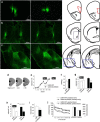The Medial Orbitofrontal Cortex Regulates Sensitivity to Outcome Value
- PMID: 27098701
- PMCID: PMC4837686
- DOI: 10.1523/JNEUROSCI.4253-15.2016
The Medial Orbitofrontal Cortex Regulates Sensitivity to Outcome Value
Abstract
An essential component of goal-directed decision-making is the ability to maintain flexible responding based on the value of a given reward, or "reinforcer." The medial orbitofrontal cortex (mOFC), a subregion of the ventromedial prefrontal cortex, is uniquely positioned to regulate this process. We trained mice to nose poke for food reinforcers and then stimulated this region using CaMKII-driven Gs-coupled designer receptors exclusively activated by designer drugs (DREADDs). In other mice, we silenced the neuroplasticity-associated neurotrophin brain-derived neurotrophic factor (BDNF). Activation of Gs-DREADDs increased behavioral sensitivity to reinforcer devaluation, whereas Bdnf knockdown blocked sensitivity. These changes were accompanied by modifications in breakpoint ratios in a progressive ratio task, and they were recapitulated in Bdnf(+/-)mice. Replacement of BDNF selectively in the mOFC in Bdnf(+/-)mice rescued behavioral deficiencies, as well as phosphorylation of extracellular-signal regulated kinase 1/2 (ERK1/2). Thus, BDNF expression in the mOFC is both necessary and sufficient for the expression of typical effort allocation relative to an anticipated reinforcer. Additional experiments indicated that expression of the immediate-early gene c-fos was aberrantly elevated in the Bdnf(+/-)dorsal striatum, and BDNF replacement in the mOFC normalized expression. Also, systemic administration of an MAP kinase kinase inhibitor increased breakpoint ratios, whereas the addition of discrete cues bridging the response-outcome contingency rescued breakpoints in Bdnf(+/-)mice. We argue that BDNF-ERK1/2 in the mOFC is a key regulator of "online" goal-directed action selection.
Significance statement: Goal-directed response selection often involves predicting the consequences of one's actions and the value of potential payoffs. Lesions or chemogenetic inactivation of the medial orbitofrontal cortex (mOFC) in rats induces failures in retrieving outcome identity memories (Bradfield et al., 2015), suggesting that the healthy mOFC serves to access outcome value information when it is not immediately observable and thereby guide goal-directed decision-making. Our findings suggest that the mOFC also bidirectionally regulates effort allocation for a given reward and that expression of the neurotrophin BDNF in the mOFC is both necessary and sufficient for mice to sustain stable representations of reinforcer value.
Keywords: cue; dorsal striatum; neurotrophin; operant; orbital; progressive ratio.
Copyright © 2016 the authors 0270-6474/16/364600-14$15.00/0.
Figures









Similar articles
-
Dissociable regulation of instrumental action within mouse prefrontal cortex.Eur J Neurosci. 2010 Nov;32(10):1726-34. doi: 10.1111/j.1460-9568.2010.07438.x. Epub 2010 Oct 12. Eur J Neurosci. 2010. PMID: 21044173 Free PMC article.
-
Reward-Related Expectations Trigger Dendritic Spine Plasticity in the Mouse Ventrolateral Orbitofrontal Cortex.J Neurosci. 2019 Jun 5;39(23):4595-4605. doi: 10.1523/JNEUROSCI.2031-18.2019. Epub 2019 Apr 2. J Neurosci. 2019. PMID: 30940719 Free PMC article.
-
Connections of the Mouse Orbitofrontal Cortex and Regulation of Goal-Directed Action Selection by Brain-Derived Neurotrophic Factor.Biol Psychiatry. 2017 Feb 15;81(4):366-377. doi: 10.1016/j.biopsych.2015.10.026. Epub 2015 Nov 18. Biol Psychiatry. 2017. PMID: 26786312 Free PMC article.
-
Involvement of the rodent prelimbic and medial orbitofrontal cortices in goal-directed action: A brief review.J Neurosci Res. 2020 Jun;98(6):1020-1030. doi: 10.1002/jnr.24567. Epub 2019 Dec 10. J Neurosci Res. 2020. PMID: 31820488 Free PMC article. Review.
-
Prefrontal cortical BDNF: A regulatory key in cocaine- and food-reinforced behaviors.Neurobiol Dis. 2016 Jul;91:326-35. doi: 10.1016/j.nbd.2016.02.021. Epub 2016 Feb 26. Neurobiol Dis. 2016. PMID: 26923993 Free PMC article. Review.
Cited by
-
The bidirectional effects between cognitive ability and brain morphology: A life course Mendelian randomization analysis.medRxiv [Preprint]. 2023 Nov 17:2023.11.17.23297145. doi: 10.1101/2023.11.17.23297145. medRxiv. 2023. PMID: 38014064 Free PMC article. Preprint.
-
Review of Orbitofrontal Cortex in Alcohol Dependence: A Disrupted Cognitive Map?Alcohol Clin Exp Res. 2020 Oct;44(10):1952-1964. doi: 10.1111/acer.14441. Epub 2020 Sep 20. Alcohol Clin Exp Res. 2020. PMID: 32852095 Free PMC article. Review.
-
Neighborhood Beauty and the Brain in Older Japanese Adults.Int J Environ Res Public Health. 2022 Dec 30;20(1):679. doi: 10.3390/ijerph20010679. Int J Environ Res Public Health. 2022. PMID: 36612997 Free PMC article.
-
Chemogenetic Manipulations of Ventral Tegmental Area Dopamine Neurons Reveal Multifaceted Roles in Cocaine Abuse.J Neurosci. 2019 Jan 16;39(3):503-518. doi: 10.1523/JNEUROSCI.0537-18.2018. Epub 2018 Nov 16. J Neurosci. 2019. PMID: 30446532 Free PMC article.
-
Pyk2 Stabilizes Striatal Medium Spiny Neuron Structure and Striatal-Dependent Action.Cells. 2021 Dec 7;10(12):3442. doi: 10.3390/cells10123442. Cells. 2021. PMID: 34943950 Free PMC article.
References
Publication types
MeSH terms
Substances
Grants and funding
LinkOut - more resources
Full Text Sources
Other Literature Sources
Molecular Biology Databases
Miscellaneous
